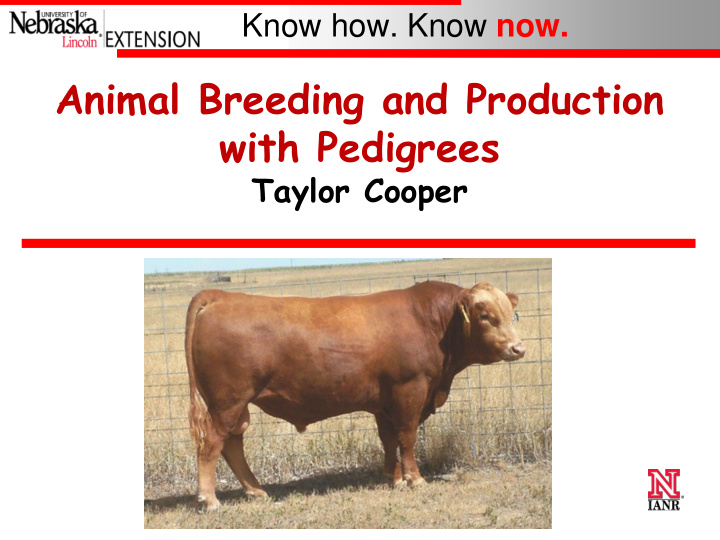



Know how. Know now. Animal Breeding and Production with Pedigrees Taylor Cooper
Know how. Know now. DNA, Chromosomes, & Genes ✓ Number & size of chromosomes differ by species ➢ Humans: 23 pairs of chromosomes • 22 pairs of autosomes • 1 pair of sex chromosomes ➢ Pigs – 19 pairs ➢ Cattle – 30 pairs ➢ Dogs – 39 pairs. University of Nebraska – Lincoln
Know how. Know now. Recessive vs. Dominant Traits ✓ Dominant Trait = trait that is expressed in an offspring if a parent give that trait Will be expressed both if both parents pass it down or if one does ➢ Humans-black hair is dominant ✓ Recessive Trait = trait that is carried by a person without appearing in person Requires both parents to pass the recessive gene down for it to be expressed in offspring Humans-red hair is recessive University of Nebraska – Lincoln
Know how. Know now. Genotype vs. Phenotype ✓ Genotype = genetic makeup of a trait ➢ “BB” vs “Bb” vs “bb” ✓ Phenotype = expressed characteristics ➢ Influenced by BOTH Genetics & Environment ➢ Color of Hair/Fur ➢ Color Blindness University of Nebraska – Lincoln
Know how. Know now. Punnett Square: b B B BB Bb bb b bB University of Nebraska – Lincoln
Know how. Know now. Pedigrees ✓ Are the records that show patterns of inheritance ✓ Useful in determining if a trait is dominant or recessive in a family line ➢ Can be used to determine if a trait is sex-linked or autosomal ✓ Allows genetic disorders to be tracked through multiple generations University of Nebraska – Lincoln
Know how. Know now. What is on a Pedigree? ✓ Name ✓ Registration number ✓ Type rating ✓ Production record ✓ Show-ring winnings ✓ Study carefully they can sometimes be misleading University of Nebraska – Lincoln
Know how. Know now. Pedigree Symbols University of Nebraska – Lincoln
Know how. Know now. What are the genotypes of each person in this pedigree? University of Nebraska – Lincoln
Know how. Know now. University of Nebraska – Lincoln
Know how. Know now. Autosomal Traits ✓ Trait not dependent on sex-will be expressed on a autosome chromosome ✓ Autosomal dominant inheritance = only one copy of allele is necessary for an individual to express trait Myotonic muscular dystrophy or Huntington disease Autosomal recessive inheritance = two copies of a disease allele are required for an individual to express trait Sickle cell anemia University of Nebraska – Lincoln
Know how. Know now. Sex-linked Traits Trait linked to a sex chromosome-normally linked to X chromosome X-linked dominant inheritance = only one copy of an allele on X chromosome is required for an individual to be susceptible Fragile X syndrome X-linked recessive inheritance = two copies of a disease allele on the X chromosome are required for an individual (in females) Hemophilia A University of Nebraska – Lincoln
Know how. Know now. University of Nebraska – Lincoln
Know how. Know now. University of Nebraska – Lincoln
Know how. Know now. Calculation of Breed Genetics University of Nebraska – Lincoln
Know how. Know now. Uses of Pedigrees ✓ Different based on species: ➢ Humans = tracking genetic disease ➢ Dairy cattle = ancestry milk production ➢ Horses = racing results, showing results ➢ Meat Production Animals (cattle, hogs, poultry) = purebreds or evaluating breeding probability ➢ Dogs = purebreds University of Nebraska – Lincoln
Know how. Know now. Evaluating Animals ✓ Can’t just use pedigrees when evaluating animals for breeding and production purproses ✓ Need to look at production records ➢ Milk = Dairy cattle, goats ➢ Eggs = Poultry ➢ Wool = Sheep ✓ Health Records ✓ Expected Progeny Difference (EPDs) ➢ Beef Cattle, Hogs, Sheep, etc. ✓ Live Evaluations ➢ Structure, Muscling, Finish University of Nebraska – Lincoln
Know how. Know now. Key Points: Pedigrees ✓ Dominant vs. Recessive Traits ✓ Genotype vs. Phenotypes ✓ Pedigrees a record of the ancestry of individual ➢ Used for genetic diseases, determining traits, purebred records ✓ Autosomal vs. X-linked traits and inheritance ✓ Pedigrees aren’t the only thing used to select production and breeding livestock University of Nebraska – Lincoln
Know how. Know now. Extension is a Division of the Institute of Agriculture and Natural Resources at the University of Nebraska – Lincoln cooperating with the Counties and the United States Department of Agriculture. The Youth Development program abides with the nondiscrimination policies of the University of Nebraska – Lincoln and the United States Department of Agriculture. University of Nebraska – Lincoln
Recommend
More recommend